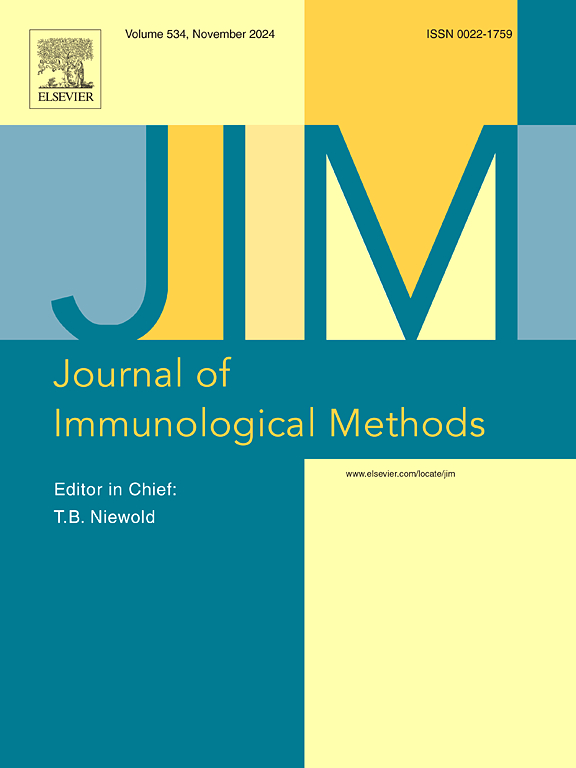使用重组抗原 rLicNTPDase-2 对哥伦比亚犬利什曼病血清诊断进行间接 ELISA 试验的初步实地评估
IF 1.6
4区 医学
Q4 BIOCHEMICAL RESEARCH METHODS
引用次数: 0
摘要
利什曼病是一个重大的公共卫生问题,在城市地区,狗是主要的贮存者,并助长了利什曼病的传播。诊断受感染的狗是公共卫生干预的关键步骤,开发新的诊断平台可以大大加强世界各地的工作。鉴于哥伦比亚可用的诊断方法有限,本研究评估了基于重组蛋白 rLicNTPDase-2 的间接酶联免疫吸附试验(ELISA)检测受感染狗体内利什曼原虫的有效性。血清样本从流行区和非流行区的狗身上采集,并根据之前的寄生虫学诊断结果归类为自然标准。结果显示有 24 个真阳性 (TP) 和 9 个真阴性 (TN)。随后,该检测法与标准检测法一起,用有症状和无症状动物的样本进行了验证,结果显示特异性为 96%,灵敏度为 81%,有效率为 90.6%,阳性预测值为 92.8%,阴性预测值为 89.6%。阳性似然比(RV+)为 20,阴性似然比(RV-)为 0.19,表明该方法具有高度相关性和强大的临床实用性。曲线下面积(AUC)为 1.00,表明该检测具有出色的鉴别能力,明显偏离参考对角线。费舍尔精确检验确定的 TN 和 TP 结果之间的显著差异(p < 0.0001)进一步证明了这一点。163 只动物的检测结果显示,阳性样本占 47%,阴性样本占 46%,阳性样本和阴性样本的平均光密度 (OD) 值差异显著(p < 0.05)。这些结果表明,ELISA 检测能根据 OD 值有效区分阳性和阴性样本。这项研究表明,基于重组抗原 rLicNTPDase-2 的 ELISA 可以作为哥伦比亚犬类利什曼病血清诊断的可行替代方法。本文章由计算机程序翻译,如有差异,请以英文原文为准。

Preliminary field evaluation of indirect ELISA test using the recombinant antigen rLicNTPDase-2 for serodiagnosis of canine leishmaniasis in Colombia
Leishmaniasis is a significant public health concern, with dogs as the primary reservoir in urban scenarios and facilitating transmission. Diagnosing infected dogs is a crucial step for public health interventions, and the development of new diagnostic platforms can significantly enhance efforts in various regions worldwide. Given the limited availability of diagnostic methods in Colombia, this study evaluates the effectiveness of an Indirect Enzyme-Linked Immunosorbent Assay (ELISA) based on the recombinant protein rLicNTPDase-2 to detect Leishmania in infected dogs. Serum samples were collected from dogs in both endemic and non-endemic areas and classified as natural standards based on prior parasitological diagnoses. The results revealed 24 true positives (TP) and 9 true negatives (TN). Subsequently, the test was then validated with samples from symptomatic and asymptomatic animals, alongside the standards, yielding a specificity of 96 %, a sensitivity of 81 %, efficiency of 90.6 %, a positive predictive value of 92.8 %, and a negative predictive value of 89.6 %. The positive likelihood ratio (RV+) was 20, while the negative likelihood ratio (RV-) was 0.19, indicating high relevance and a robust clinical utility. The area under the curve (AUC) was 1.00, suggesting that the test has excellent discriminatory ability, significantly deviating from the reference diagonal. This is further supported by the significant difference(p < 0.0001) between TN and TP results determined by Fisher's exact test. Involving 163 animals showed 47 % positive and 46 % negative results with a significant difference (p < 0.05) in the mean optical density (OD) values between positive and negative samples. These findings indicate that the ELISA test effectively differentiates between positive and negative samples based on OD values. This study suggests that ELISA based on the recombinant antigen rLicNTPDase-2 could serve as a viable alternative for the serodiagnosis of leishmaniasis in canines in Colombia.
求助全文
通过发布文献求助,成功后即可免费获取论文全文。
去求助
来源期刊
CiteScore
4.10
自引率
0.00%
发文量
120
审稿时长
3 months
期刊介绍:
The Journal of Immunological Methods is devoted to covering techniques for: (1) Quantitating and detecting antibodies and/or antigens. (2) Purifying immunoglobulins, lymphokines and other molecules of the immune system. (3) Isolating antigens and other substances important in immunological processes. (4) Labelling antigens and antibodies. (5) Localizing antigens and/or antibodies in tissues and cells. (6) Detecting, and fractionating immunocompetent cells. (7) Assaying for cellular immunity. (8) Documenting cell-cell interactions. (9) Initiating immunity and unresponsiveness. (10) Transplanting tissues. (11) Studying items closely related to immunity such as complement, reticuloendothelial system and others. (12) Molecular techniques for studying immune cells and their receptors. (13) Imaging of the immune system. (14) Methods for production or their fragments in eukaryotic and prokaryotic cells.
In addition the journal will publish articles on novel methods for analysing the organization, structure and expression of genes for immunologically important molecules such as immunoglobulins, T cell receptors and accessory molecules involved in antigen recognition, processing and presentation. Submitted full length manuscripts should describe new methods of broad applicability to immunology and not simply the application of an established method to a particular substance - although papers describing such applications may be considered for publication as a short Technical Note. Review articles will also be published by the Journal of Immunological Methods. In general these manuscripts are by solicitation however anyone interested in submitting a review can contact the Reviews Editor and provide an outline of the proposed review.

 求助内容:
求助内容: 应助结果提醒方式:
应助结果提醒方式:


